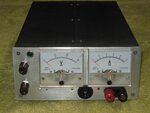xavier60
Newbie

Many designs to be found on the internet have performance problems and/or are overly complicated.
A lot have poor loop compensation or none at all, covered up by an oversized output capacitor.
This design actually evolved from one of these dysfunctional designs.
It is genuinely stable and needs one control rail.
There is a small current flow through the shunt resistor from the 8V regulator, but because it's constant, it causes no practical problem.
The function of D5 is not obvious. If a sudden output current overload causes the Inverting input of the CC op-amp to go negative enough to cause D5 to conduct, the op-amp's negative feedback path gets shorted to ground causing its output to swing hard low, rapidly discharging the feedback capacitor.
This results in very fast current limiting when needed, about 5µs.
Also not so obvious. This topology briefly tolerates applied reverse polarity.
D7 and the Polyswitch are there just to protect the Preload circuit.
It's fed by a 100VA transformer with two 15VAC secondaries which are configured by the relay in parallel or series to suit the output voltage.
A lot have poor loop compensation or none at all, covered up by an oversized output capacitor.
This design actually evolved from one of these dysfunctional designs.
It is genuinely stable and needs one control rail.
There is a small current flow through the shunt resistor from the 8V regulator, but because it's constant, it causes no practical problem.
The function of D5 is not obvious. If a sudden output current overload causes the Inverting input of the CC op-amp to go negative enough to cause D5 to conduct, the op-amp's negative feedback path gets shorted to ground causing its output to swing hard low, rapidly discharging the feedback capacitor.
This results in very fast current limiting when needed, about 5µs.
Also not so obvious. This topology briefly tolerates applied reverse polarity.
D7 and the Polyswitch are there just to protect the Preload circuit.
It's fed by a 100VA transformer with two 15VAC secondaries which are configured by the relay in parallel or series to suit the output voltage.


